On January 30, the Japanese American Museum of San Jose (JAMsj) helped organize the Seventh Annual Fred Korematsu Day of Civil Liberties and the Constitution, an event created to honor the Japanese American civil rights leader and build upon his legacy of advocacy and civic education. This year’s event was held virtually and kicked off with presentations of vintage 48-star flags signed by Japanese American incarceration camp survivors, followed by a panel discussion revolving around the theme, “Building Resilience in the Fight for Racial Justice: Learning from the Past to Build a Better Future.”
Featured panelists included Dr. Karen Koremetsu, founder and executive director of The Fred T. Korematsu Institute and daughter of Fred Korematsu; Santa Clara County Superior Court Judge Johnny Gogo, who spearheaded the flag signing project; and Zahra Billoo, executive director of Council on American-Islamic Relations - San Francisco Bay Area (CAIR-SFBA). Adena Ishii, a student at Santa Clara University School of Law and a JAMsj volunteer, moderated the panel.
In case you missed the event, you can watch the recording below. We’ve also included a transcript for the first half of the panel discussion
Besides JAMsj, other official sponsors of the event included The Santa Clara County Superior Court, The Fred T. Korematsu Institute, Asian Law Alliance, CAIR-SFBA, Asian Pacific American Bar Association of Silicon Valley, and Santa Clara University School of Law.
Panel Discussion - Partial Transcript
Below is a transcript of the first half of the panel discussion.
Note: The transcript has been edited for clarity.
Introductions
“We need to agree to disagree, find that common ground and build upon that, so we can make the changes in our country. That’s what this day represents. ”
Adena Ishii: I introduced myself a bit earlier, but just to say a little more, my name is Adena Ishii, and I am a student at Santa Clara University School of Law, third year there, as well as a volunteer with the Japanese American Museum of San Jose. I myself am Japanese American, and I'm proud to be here today to moderate our panel.
Let's have the panelists introduce themselves. I'd like to start off with Dr. Karen Korematsu. Thank you so much for being here with us, and also happy birthday to your father.
Dr. Korematsu: Well, thank you, Adena, and hello, everyone. Yes, happy Fred Korematsu Day of Civil Liberties and the Constitution, and as I always say, Happy Birthday, Daddy. He would have been 103 years old, which is incredible. But more importantly, his legacy just seems to grow in leaps and bounds. Thanks to everyone across this country. It's truly amazing.
For people that don't know, Fred Korematsu Day of Civil Liberties and the Constitution is the first day in U.S. history to be named after an Asian American, and so that's what my father's day represents. Especially during this time of our big divide, obviously in this country and even around the world, I want you to know that my father lived by his principles of right and wrong. He treated everyone like he wanted to be treated.
Certainly he had pushback. He had criticism. People were against him. His own Japanese American community in 1942 vilified and ostracized him for taking a stand against the government, but he kept on for what I call like a quiet warrior. He just never would give up, and this day represents our civil liberties and the Constitution.
My father never blamed anyone. He was never angry. He just believed that the government was wrong, and he was right to take a stand — that's what we all have the ability to do, as long as it's not hateful, as long as there's no violence — that truly we need to respect each other, respect each other's differences, to try to understand each other's differences and to appreciate them and to listen. We need to agree to disagree, find that common ground and build upon that, so we can make the changes in our country. That's what this day represents.
The incredible project — I must have to add again, my deepest, profound thanks to Judge Gogo, for this flag project. I have to tell you and share. Fred Korematsu Day is also recognized in Hawaii and Virginia and Florida, New York City, and now even the state of Arizona. I'm taking this flag to Arizona, presenting it actually. We're meeting with the Senate and the House. They're going to be reading the proclamation or the legislative bill for Fred Korematsu Day, and I'm going to show them the flag, because they have two incarceration camps, Gila River and Poston, and because they took an oath to uphold our Constitution, and this is what this is all about, and to encourage civic participation, because that's how we're going to make a difference.
Judge Johnny Gogo presents to Dr. Karen Korematsu a vintage 48-star flag signed by Japanese American internment camp survivors.
I don't care which party you're with, but to help support our country and find those causes that we believe in. So I'm looking forward to our conversation, and thank you all, especially Judge Roberta Hayashi, for your inspiration and creating the seventh annual Fred Korematsu Day for Santa Clara and San Jose, and all those who participated behind the scenes and in front of the camera. So thank you all very much.
Adena Ishii: Thank you. Judge Gogo, if you could introduce yourself, please. And also just your connection with — I know your flag signing projects, of course, but otherwise.
Judge Gogo: Thank you very much, Adena, for being our moderator. It is an honor and a pleasure for me to be on this panel. I've actually watched these presentations for Fred Korematsu Day here in San Jose, like Judge Roberta Hayashi said, since 2015, and that's how I got involved in learning more about the events. My connection again, so starts back to 2015, and then continues as I got appointed to the bench in late 2019, and was invited to be a speaker. Again, I just thought to myself, how can I get more people involved in learning about this injustice, so that we can try and prevent these atrocities from happening again?
So that's, in a nutshell, how I got involved in the project, the Korematsu Day, but I would be remiss if I did not also acknowledge the legal team that worked on Fred Korematsu's case, in particular, Dale Manami, Peter Irons — who's a professor at U.C. San Diego, was one of my professors back at U.C. San Diego back in the day — Don Tamaki, Robert Rusky, who recently died December of 2021. Just really, within weeks ago, Karen Kai, Lorraine Bannai, Eric Yamamoto, Leigh-Ann Miyasoto, Edward Chen, Dennis Hayashi, Donna Komure- Toyama, and Marjie Barrows. That was the legal team, as Dr. Karen Komatsu knows, that helped overturn the conviction with the coram nobis. So thank you to them. This 48-star flag signing project was born [out] of my participating and listening to Karen Korematsu, Dale Minami, Roberta Hayashi, other speakers, and it's been my honor to travel the country to have those survivors sign these flags.
We now have five flags that we have signed. The first flag is donated to the Japanese American Museum in San Jose. The second flag, I plan to donate that to the Japanese American National Museum in Los Angeles. The third flag has been donated to the Fred T. Korematsu Institute. The fourth flag is going to be traveling with Dr. Karen Korematsu to the Arizona state legislature tomorrow, and then hopefully we can match that up with Professor Billingslea's project and have that travel to different colleges and universities to help educate future generations of students. And then the fifth flag actually has been donated to the Japanese American Museum in Portland, Oregon. We can't forget about the state of Oregon, city of Seattle, which also suffered from the Executive Order 9066. So, let me stop there, because I know that we have other questions and other panelists, and so I'll turn it back over to you, Adena.
Adena Ishii: Yes, thank you, Judge Gogo. Zahra, if you could introduce yourself,
Zahra Billoo: Thank you so much, Adena, and really thank you to my co-panelists, the Korematsu Institute, the Santa Clara County Superior Court, and Santa Clara University for making this possible. Karen, I haven't seen you in person in a couple of years. I remember in 2020, I thought COVID might just be two weeks, and here we are in 2022, doing this program virtually. It's really an honor to be here with all of you again today.
My name is Zahra Billoo. I'm the executive director at CAIR-San Francisco Bay Area. We're the nation's largest American Muslim civil rights organization, and our work includes both protecting the rights of American Muslims and frankly, by extension, all Americans, because when we protect one minority group, everybody benefits — when one minority group is targeted, everyone is at risk — but also empowering the American Muslim community, to speak up and protect themselves, to advocate for legislation, to tell their stories, and to hold people accountable when they are harming us.
Korematsu Day is very personally and professionally important to me, because when I was just 17, and 9/11 happened, I remember, before any community came forward, it was the Japanese American community that reached out to the Muslim community and said, we've been here. We know what this is like, and we know what happens on day two to all of you, and so we won't let that be the case. I remember I was in Southern California at the time. The Japanese American leaders stepped forward. They joined our community at press conferences, they raised their voices, and they advocated for us. So when I began my work at CAIR, I got to meet Dr. Karen and learn more about her father's legacy.
One of the questions that many of us continue to ask is, why don't more people know about this? Could we protect ourselves from future harm by learning from our history, and not just from our history in terms of what happened and what was done in under the false guise of national security, but also, Fred's courage in speaking out against all odds, speaking out when it was frightening, speaking out, frankly, when his community wasn't always there with him, and the forces of the government were seeking to harm him.
So today's special, because our work remains to be done. We see as we look at what is happening to Afghan refugees coming in, as we look at Central American migrants coming in, and as we look at how black and brown people are treated right here, in our country, when they're already here and have been here for generations, we're reminded that we have to continue to talk about the Korematsu legacy.
Racial Justice and Building Resilience
“We build resilience by celebrating the wins, by engaging in self-care, and by building solidarity across communities, so that we know that when we’re in the middle of it, we’re not alone.”
Adena Ishii: Thank you so much for introducing yourself and for sharing why this day is so important to you and should be important to all of us. I really want to start with talking about our theme for the day.
Today our theme is “Building Resilience in the Fight for Racial Justice.” We have these events every year, and I think that's very important, but I want to acknowledge that we're in this time where people are so separated politically, but also physically with the COVID pandemic. We had planned in hopes to have this event in person, and here we are, online, and that has presented its own challenges.
But in any case, our theme again, “Building Resilience and Fight for Racial Justice,” and the question I have for you — first off, the U.S. Constitution provides that all persons are entitled to equal protection under the law, and that no person may be deprived of life, liberty, or property without due process of law. The concept of racial justice started when the Fourteenth Amendment passed after the Civil War, but over 150 years later, it's not fully realized. So I'm curious, for all of you, what does racial justice mean to you? Also, how are you building resilience in your work? Maybe I'll send it back to Zahra first, since we just heard from you.
Zahra Billoo: Racial justice to me, and the work that I do, is about realizing that promise. The first step is acknowledging that we are so far from them, that the people who wrote that promise, were themselves, often working to undermine it. When we start there, and we acknowledge where we are, we can then start to say, okay, what needs to happen? Racial injustice happens in so many ways, structurally. A lot of times, we focus on individual hatred and individual crimes, and that's important, but a lot of times it is the case that our government is perpetrating these harms. So we have to name the problem, we have to look at the many ways in which injustice is happening, and then we have to work towards resolving this for all communities - the Japanese American community, the American Muslim community, Black Americans, Latinx individuals, and not just racial and religious groups, right, but different economic status, different citizenship status, and so on. And the work is hard.
Your question of resilience is one that resonates deeply, because the work is hard, and it's exhausting. Frankly, we're here talking about this on a Sunday, and so it's not just even a nine-to-five job for people who choose to take an interest in it. It is a life calling. We build resilience by celebrating the wins, by engaging in self-care, and by building solidarity across communities, so that we know that when we're in the middle of it, we're not alone.
Adena Ishii: Thank you. Yeah, I want to come back to this engaging and communities and self-care piece later. Dr. Korematsu, would you like to respond?
Dr. Korematsu: Yes, thank you. Our focus at the Korematsu Institute is civics and civic engagement and participation. So we start with education. That was what was so important to my father, that we carry on with education, but now we need to be more purposeful. This is not about just talking about history. History is now present, and we need to teach our young people about the collective marginalization of all ethnicities, including the indigenous friends and American Indians for whom this has been happening since day one, that these struggles have been ongoing. It's not like just all of a sudden, we've had anti-Asian hate and violence. This history goes even beyond the Chinese Exclusion Act of 1882.
This is what we do in our country. People should not be afraid of that. This is what's really of concern to me now, that people are concerned. Even when we're talking about injustice — to me, injustice is book burning, or book banning, or to attack some of the curriculum that's in schools. I'm fighting for ethnic studies across this country to be in school, so that we can learn about each other's diversity and appreciate it. The injustice comes in all different levels, and happens to all different ethnicities, and the way that we build this is together, to build that resilience to work together, to say, okay, these are the issues. We're not always going to agree, but to find that common ground, and to build on that. That's the civil liberties that we need to promote and preserve, and our Constitution.
I mean, we have free speech, and as long as we appreciate that, we not may not always agree, that's okay, but to do it in a mindful way, where we can learn from each other, and to listen and to keep pushing, because, as my father... I mean, mind you, when Executive Order 9066 was issued, all due process of law was denied, and we need to be mindful of that. That's when you speak up and say, no, this is part of our Constitution. You can't do that. At least we now have the organizations to support each other and to work together. I know we're going to talk a little bit about allyship, but that's part of it as well.
Adena Ishii: Thank you. Judge Gogo, do you have anything you'd like to add?
Judge Gogo: Just briefly. In the chat. I'm hoping that people were able to see the name that I just put in there, Mas Hashimoto, Liberty Lost ... Lessons and Loyalty. One of the fantastic stories from this flag signing project journey that I embarked upon was my meeting of Mas Hashimoto and his wife, Marcia Hashimoto, who live in Watsonville, California. Mas, when he was a young boy, was imprisoned with his family at the Poston prison camp in Arizona. Mas had some brothers who ended up serving in World War II. Mas himself, when he was eligible, served in the military in the Korean War, to show their loyalty to the United States, the country that unfortunately had imprisoned them during World War II. Mas later becomes a U.S. history teacher at Watsonville High School. He retired a while ago, but he taught for nearly 35 years, and he put together this TED talk that was put online in 2018.
I would invite the audience to Google that TED talk from Mas Hashimoto and listen to his message, because as a U.S. history teacher, Mas, and I, as a minor in history myself, I really do appreciate the lessons of history, and Mas takes us back to the days of our Constitution that did not outlaw or prohibit slavery, in through the Chinese Exclusion Act that Dr. Karen Korematsu mentioned, and then the Alien Land Law Act that prohibited primarily the Japanese Americans and the Japanese nationals from owning land here in California through World War II, the Executive Order 9066. That's what I would add to this part of the conversation, that this history has been going on for a while. Please listen to Mas Hashimoto's short 20-minute TED Talk to understand more about that.
Allyship in the 21st Century
“The point to allyship is getting out of our silos, and working even across the aisle, working with different people in different organizations, and finding that common ground where we can make a difference.”
Adena Ishii: Thank you. I'd like to return to this conversation that we had just briefly about resilience and allyship. In the videos earlier, we heard a little bit about how Japanese Americans really got involved after 9/11 to prevent discrimination and hate against Muslim Americans. That allyship is very important in many of our different fights for racial justice. So if I could have Zahra speak a little bit more about what does allyship mean in the 21st century, or anyone else for that matter?
Dr. Korematsu: Well, allyship, really the meaning of the word is to work together. As I pointed out, in 1942, when the Executive Order 9066 was issued, there weren't the organizations around to stand up and speak out against this. You had the Quakers, who were very peaceful. You had the ACLU, but they even threatened Mr. Besig, who was the executive director of the Northern California affiliate that wanted to take on my father's Supreme Court case, with ouster. The ACLU President, Roger Baldwin, said, we don't take on cases, only amicus briefs, but then, he was friends with President Roosevelt, and everyone was willing to support the war effort. I mean, that's come no different than what happened after 9/11, and certainly, we rally around as Americans, as we should.
But at the same time, there was no one, and at least now, as I said before, we do have organizations that can help each other to support each other and to make sure that we get out of our silos. The point to allyship is getting out of our silos, and working even across the aisle, working with different people in different organizations, and finding that common ground where we can make a difference.
I know the governors of each state are now meeting in Washington, D.C. They're having a [National] Governors Association meeting, because I just met with Governor Ducey. They've said, we don't always agree. They come from different parties, but they still try to find that common ground to find those issues that they can build upon, and then try to understand each other's differences and where the problems are. It's not easy. It takes a lot of time. You're not always going to agree, but we all have to try. We have a privilege in this country, where we can do that. In other countries, you cannot. It's a matter of appreciating each other's differences in trying to understand them. Building allyship is to work on those issues and even voting.
Goodness sakes, right now voting is such a big issue. Everyone should be a part of that, ally, and work together to make sure that people are registered, have the right that can be there, to vote, understand the issues, whether it's community, state, national. It's all part of what we need to do to make this country better. To me, allyship is being American and supporting our efforts and our citizenship.
Adena Ishii: Thank you. Zahra, I saw that you had unmuted. Did you want to say something?
Zahra Billoo: Dr. Karen put it all really well. I would offer some additional considerations around allyship. The first is we have to let the most impacted people lead, right. So if I want to be an ally to people in different parts of the U.S. that are facing restrictions on their voting rights, right, they tell me what to do. If I want to be an ally to black communities who are facing just continued police violence, they tell me what to do. So that's the first thing I remind myself around allyship, which is to follow the lead of the most impacted people.
The second is that so much of allyship is contingent on relationship building. So if I have never talked to my neighbors, I've never talked to my friends, I've never gotten out of my silo, and I show up in a time of crisis to be an ally, sure the effort is sincere, but it may be jarring for people who don't know me there. They're asking, who are you? How do I know that I can trust you?
And that takes me to my third point, which is that allyship is at times most tested when it is uncomfortable. The Japanese American community risked unpopularity, risked discomfort, and continues to be really principled in their solidarity with the Muslim community, and so the question is, are you there for me when it's hard? Are you there for me when you have something to lose?
When we consider these three things together, that's honestly when I think we get the strongest allyship. I let the most impacted person lead. I invest in my relationship with them. It's not an exchange of allyship, I am there for them as a friend, as a community member, and as the neighbor. And I am there for them, when it is less popular to do so. I'm there for them when I may take a personal or professional risk to be in solidarity with them. So as we think about allyship, in this era, when so many times the allies are the ones that come under attack, and everyone is nervous and doesn't know who to trust, these are the things I would suggest we consider.
Adena Ishii: Thank you. I appreciate that perspective. I think that's very important. Oftentimes I have seen folks who are trying to be allies with projects that I'm working on, and they sort of come in, and they have an idea of how things should be, and it's with the best intentions, right? But you know what they say about that, right? The road to hell is paved with the best intentions. So, you know, keeping in mind who is at the center of this? Thank you.
Judge Gogo, did you have anything you want to add about allyship?
Judge Gogo: Just one small part, again, tying it back to the flag, because many people on this panel may not know, and in the audience may not know that I'm actually from the beautiful island of Guam. And so I'm Guamanian, right, Pacific Islander American, and I'm not Japanese American. Some people say, you know, Johnny, you're not Japanese American, why are you doing this project? Ultimately, it's because I'm an American, and I want to do the right thing. When you talk about allies and allyship, when I took the flag down to the 48 star flag down to Los Angeles, for the Los Angeles community to sign the flag, I was able to set up a special one-on-one signing with George Takei from Star Trek fame. George, when he was signing the flag, and we were chatting a little bit about this project, he says, "You know what you are, Johnny?" he says, "You're an ally." It's little things like that, this signing project, educating our younger generation, those little bits of things that individuals can do, adds to being an ally and allyship.
Resilience of Japanese American WWII Camp Survivors
Adena Ishii: Thank you for sharing that story. I'd like to ask you another question, Judge Gogo. In your conversations with survivors of the Japanese American concentration camps, did they ever speak about how they stayed strong during that time, going back to this resilience?
Judge Gogo: Thank you again, Adena. On these five flags, we've accumulated over 1,000 signatures from survivors. Those 1,000 signatures represent 1,000 different stories. Each individual has their own unique story.
I'm reminded of my last visit, and I was able to take at least most of these flags to all of the 10 relocation camps. The last camp that I visited, on December 31st, was Manzanar, and I had the opportunity to visit the museum at Manzanar. When you visit the museum and Manzanar, one of the photos and signs that they show you is for Manzanar's "One camp. 10,000 lives. One camp. 10,000 stories."
In my research and in reading the different memoirs and listening to the nisei generation tell me and share with me their stories, the "shikata ga nai" phrase, it cannot be helped, you know, accepting what cannot be changed and doing your best to let it roll off your back. That was the model of the first generation, or the issei generation, right, the immigrants from Japan, and those were the adults who had to take care of their children in the camps. Because they had faced this discrimination and racism when they immigrated from Japan, that was what they were used to, right? Again, as both Zahra and Dr. Karen Korematsu stated, we didn't have the allyship that we do these days, nobody standing up to help protect the Japanese American community. So they had to essentially endure or deal with it. The other Japanese word that I learned was "gaman," you know, its of Zen Buddhist origin, meaning to endure the seemingly unbearable with patience and dignity, perseverance.
Those are the key concepts that I learned from talking with those that were in the camps. That's how they had to learn to live through this. It was the issei generation that suffered the most stress and the most anxiety, because they had to leave all of their possessions behind, their belongings, their professional lives, their businesses, their schooling, etc., and forced into these relocation camps, and that is traumatizing. That is post-traumatic stress syndrome, at its definition. So that's how they got through it.
Adena Ishii: Thank you for sharing that and for sharing those stories, and just to add to that idea that there are so many different stories that each individual has their own story. I think, also, I want to comment that I know there are people who felt that gaman was not enough. Actually, the way that they were able to survive that experience was doing something, you know, fighting back against it or protesting. And, and I think that in the next sort of generation, the sansei, I've seen that a lot,
Judge Gogo: Yeah, if I can add to that. Thank you, Adena, for reminding me. Not all of the folks in the camps agreed on one particular response. Again, you have different individuals with different opinions, different mindsets. There were some in the camps that were pro-Japan. After Pearl Harbor and after the mass incarceration of Japanese Americans, there were some that were very, very much wanting to to join the United States military to fight back both in the European theater as well as the Pacific theater, and they were initially denied the opportunity to join the military, because the United States government, again at that time, prohibited Japanese Americans from joining the military. And then there were those who resisted in the camps. They resisted going into the draft. And so there were a lot of differing opinions as I learned and listened and read and studied throughout this project. Very fascinating experience for me to go on this journey. So thank you for reminding me about the differing opinions amongst the Japanese American community within the camps themselves.
Adena Ishii: Yeah, thank you. And thanks for adding on those lessons that you learned as well. I think also as a fourth-generation Japanese American, as a yonsei, one of the reasons why I'm really passionate about this work and fighting for racial justice is because of my grandparents' experience, that one of my grandmothers was in camp, and then I had two grandfathers that both served in the Military Intelligence Service, and also the 442nd [Regiment], so it's very much a part of my family history, and I think still really impacts me and how I feel, when I see racial injustice happen today.
For the full panel discussion, please watch the recording above.


















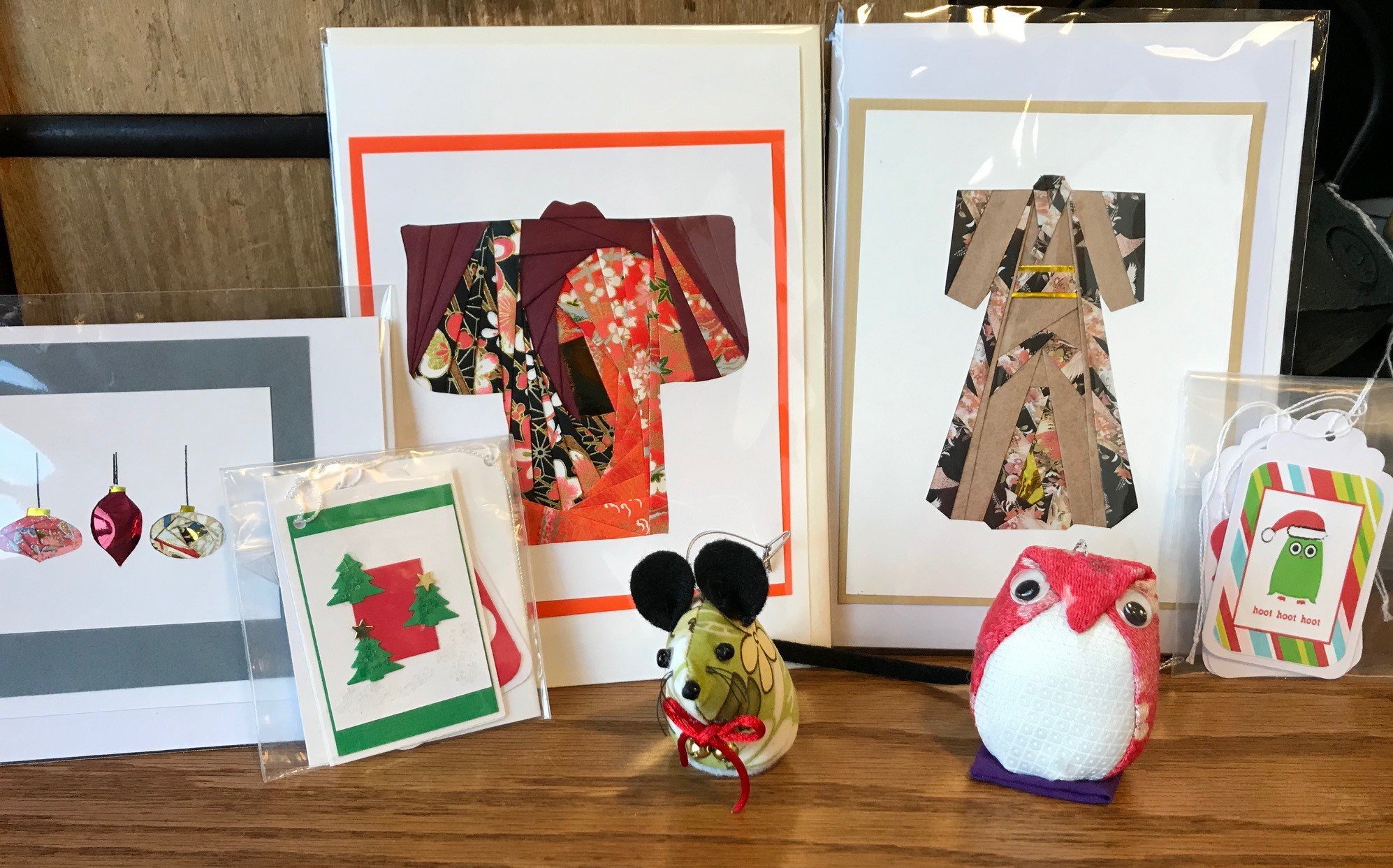













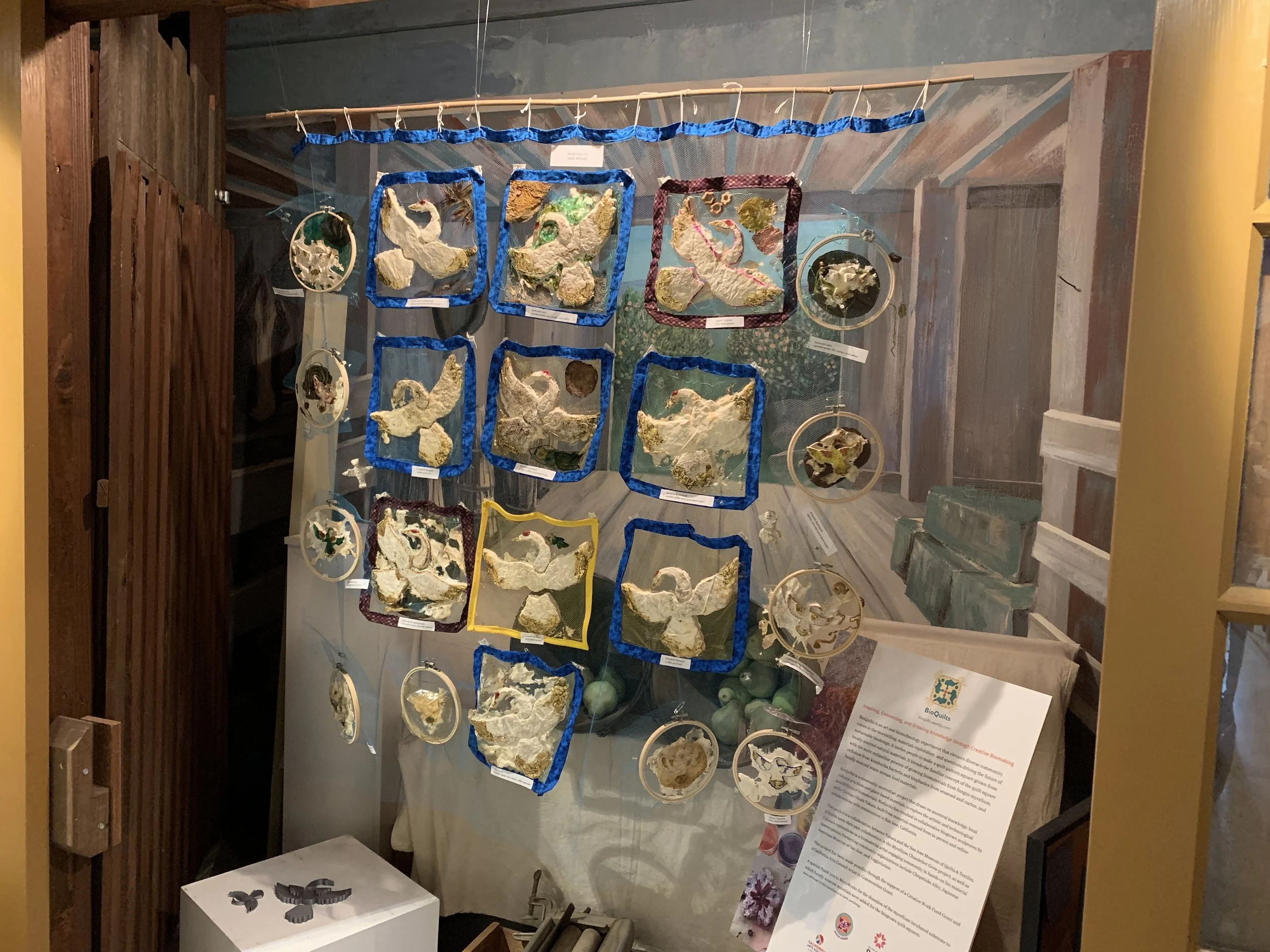




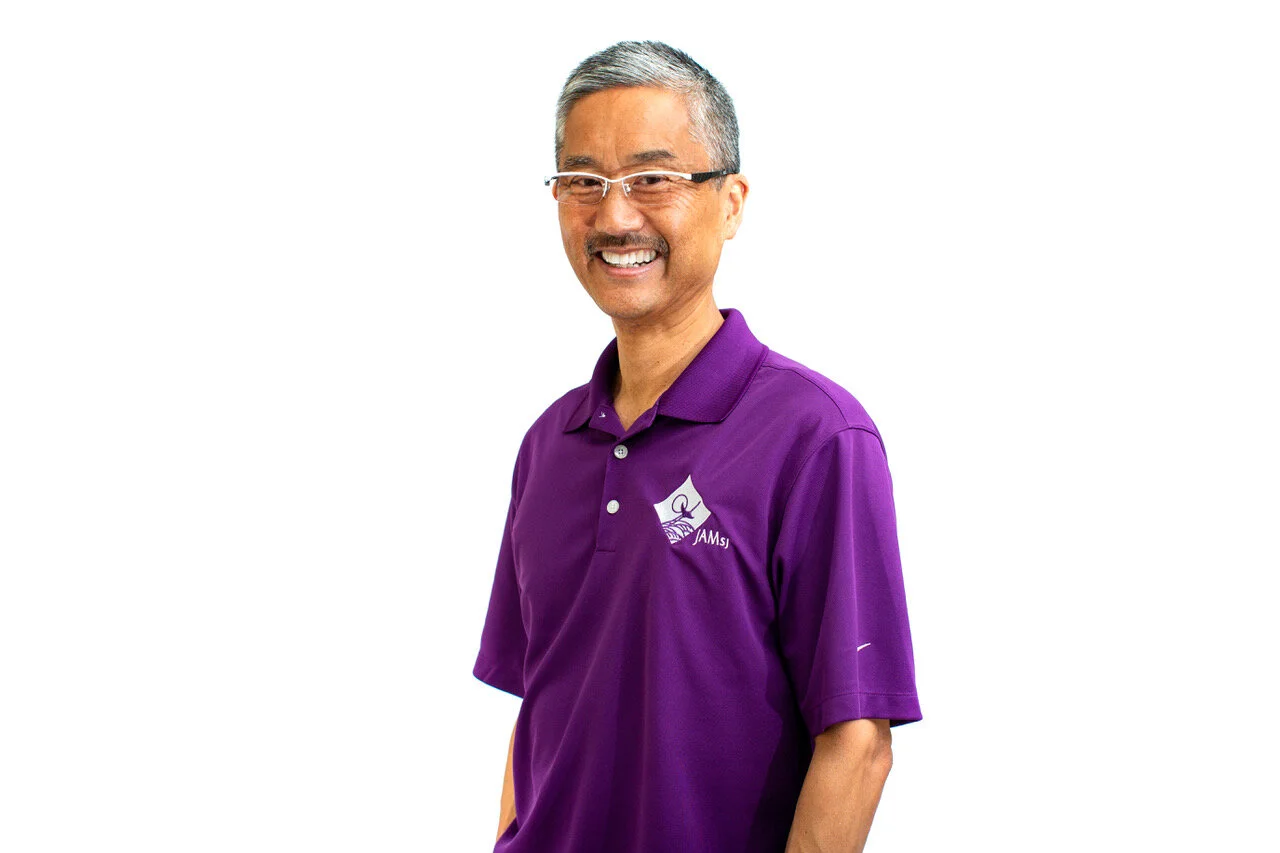
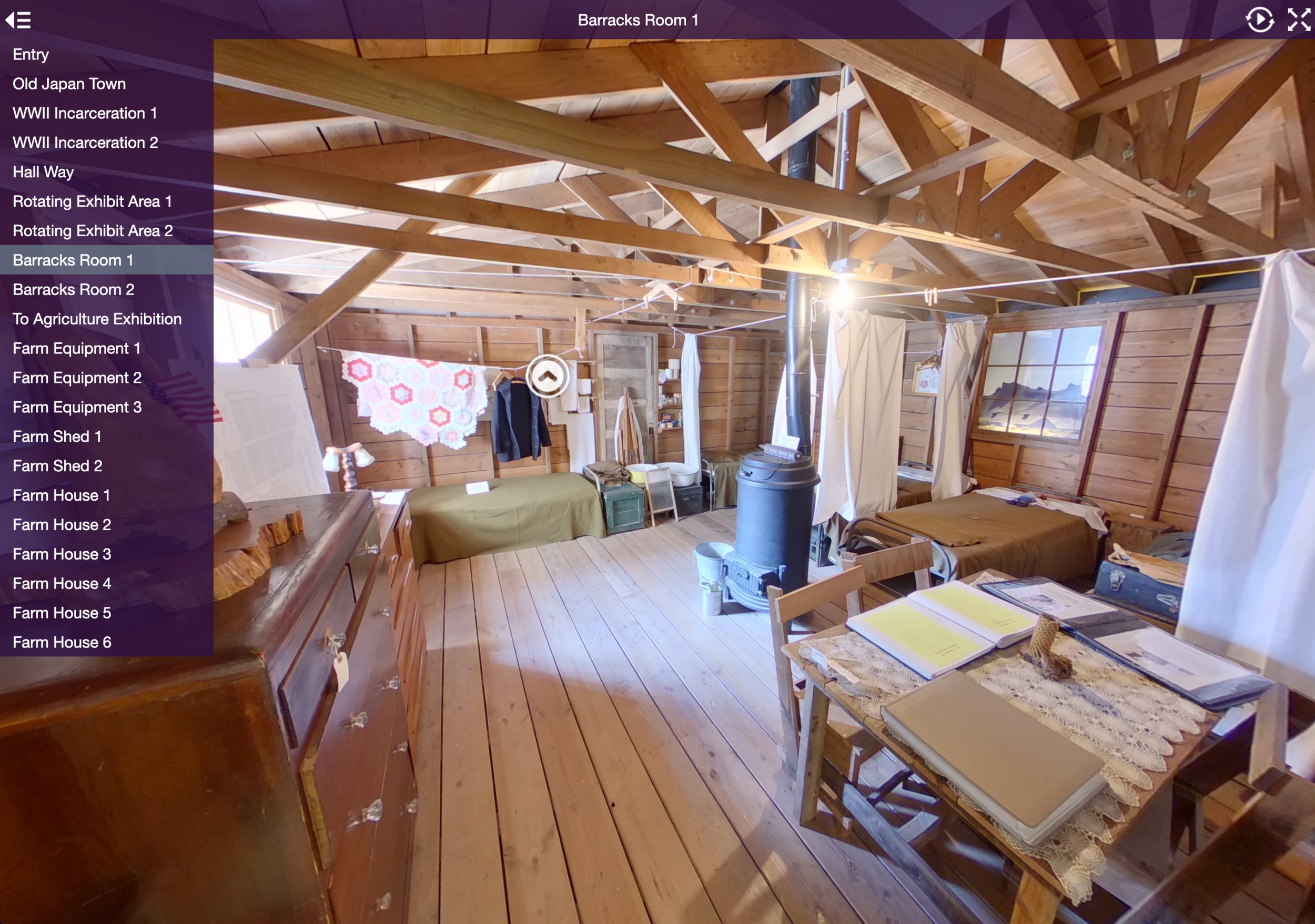

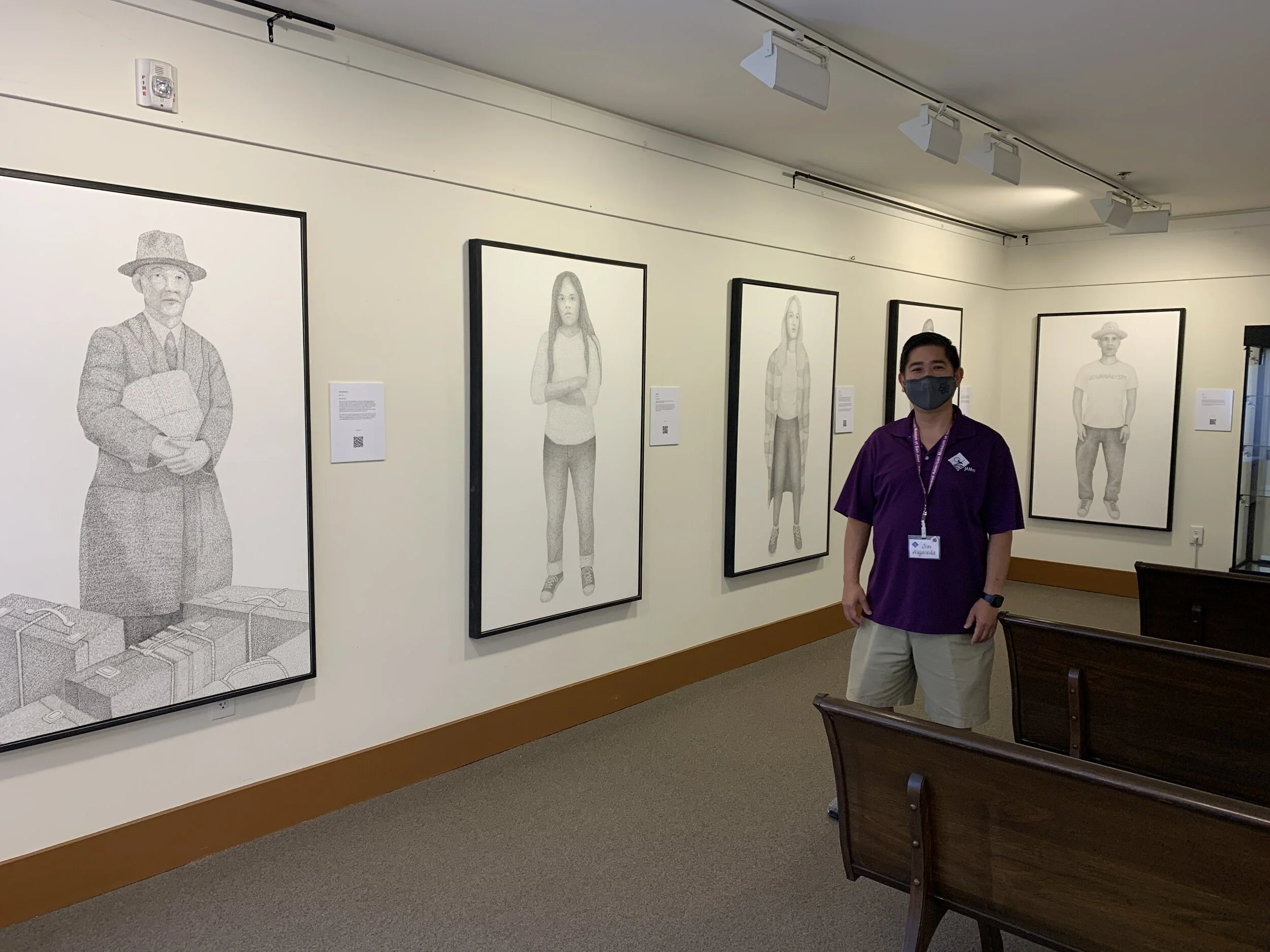







 Other prominent Americans also drew stark parallels with the World War II incarceration of Japanese Americans. Actor and activist,
Other prominent Americans also drew stark parallels with the World War II incarceration of Japanese Americans. Actor and activist,  "By blindly accepting the Government’s misguided invitation to sanction a discriminatory policy motivated by animosity toward a disfavored group, all in the name of a superficial claim of national security, the Court redeploys the same dangerous logic underlying Korematsu and merely replaces one “gravely wrong” decision with another."Although the Court's five majority justices disagreed with Justice Sotomayor, the majority opinion stated that the Court now had the opportunity to "express what is already obvious: Korematsu was gravely wrong the day it was decided, has been overruled in the court of history, and—to be clear—has no place in law under the Constitution.”The San Jose Day of Remembrance event was started 39 years ago by local activists to bring awareness of the United States government's actions to forcibly remove and disrupt the Japanese American community. The organizers, the
"By blindly accepting the Government’s misguided invitation to sanction a discriminatory policy motivated by animosity toward a disfavored group, all in the name of a superficial claim of national security, the Court redeploys the same dangerous logic underlying Korematsu and merely replaces one “gravely wrong” decision with another."Although the Court's five majority justices disagreed with Justice Sotomayor, the majority opinion stated that the Court now had the opportunity to "express what is already obvious: Korematsu was gravely wrong the day it was decided, has been overruled in the court of history, and—to be clear—has no place in law under the Constitution.”The San Jose Day of Remembrance event was started 39 years ago by local activists to bring awareness of the United States government's actions to forcibly remove and disrupt the Japanese American community. The organizers, the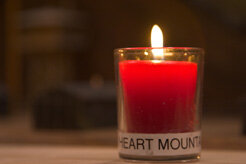 The
The 


 Jimi was a very caring person. This is also true about his wife, Eiko, and the rest of the Yamaichi family. Since Jimi's passing, I have heard numerous stories about how Jimi and Eiko took people under their wing, especially those that lost loved ones or individuals who were new to the community.I remember when I first met Jimi at my first Tule Lake Pilgrimage. I was new in the community and I didn't know anybody as I sat by myself in the auditorium. Jimi came by and sat next to me. He immediately struck up a conversation and gave me some historical items that he had collected. Jimi made me feel very special. Jimi did that with everyone.
Jimi was a very caring person. This is also true about his wife, Eiko, and the rest of the Yamaichi family. Since Jimi's passing, I have heard numerous stories about how Jimi and Eiko took people under their wing, especially those that lost loved ones or individuals who were new to the community.I remember when I first met Jimi at my first Tule Lake Pilgrimage. I was new in the community and I didn't know anybody as I sat by myself in the auditorium. Jimi came by and sat next to me. He immediately struck up a conversation and gave me some historical items that he had collected. Jimi made me feel very special. Jimi did that with everyone. I asked Jimi many questions about the
I asked Jimi many questions about the  One of my last memories of Jimi was at this year's
One of my last memories of Jimi was at this year's  On the day after his passing, it was somewhat difficult for me to give museum tours that day since I always have several Jimi stories that I incorporate into my narrative. I had to pause or slow down a bit after I became a bit emotional. I still get teary-eyed as I tell those stories but I also know that Jimi's spirit, vision, and dreams live on here at the Museum, in San Jose Japantown, at Tule Lake, and most importantly, within all of us.
On the day after his passing, it was somewhat difficult for me to give museum tours that day since I always have several Jimi stories that I incorporate into my narrative. I had to pause or slow down a bit after I became a bit emotional. I still get teary-eyed as I tell those stories but I also know that Jimi's spirit, vision, and dreams live on here at the Museum, in San Jose Japantown, at Tule Lake, and most importantly, within all of us.
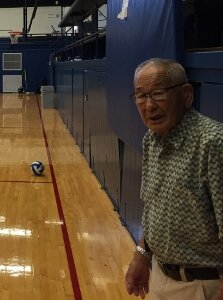

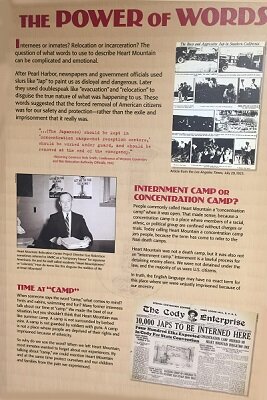 Phrasing and word usage are very important in shaping our attitudes about people, events, products, issues, and policies. For example, according to a CNBC 2013 poll, more people were opposed to President Obama's signature health care law when it was referred to as "Obamacare" rather than its official name, The Affordable Care Act. Similarly, in a 2017 IPSOS/NPR poll, more people felt that a particular tax should be abolished when it was referred to the "Death Tax" rather than the "Estate Tax," which were common terms used during policy discussions.In my
Phrasing and word usage are very important in shaping our attitudes about people, events, products, issues, and policies. For example, according to a CNBC 2013 poll, more people were opposed to President Obama's signature health care law when it was referred to as "Obamacare" rather than its official name, The Affordable Care Act. Similarly, in a 2017 IPSOS/NPR poll, more people felt that a particular tax should be abolished when it was referred to the "Death Tax" rather than the "Estate Tax," which were common terms used during policy discussions.In my 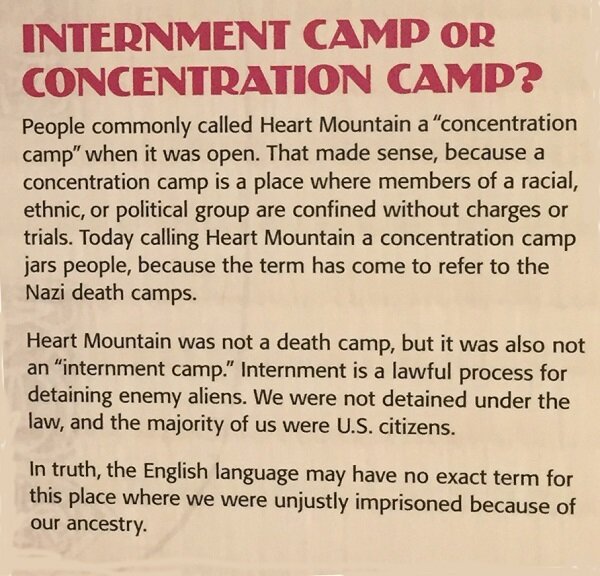
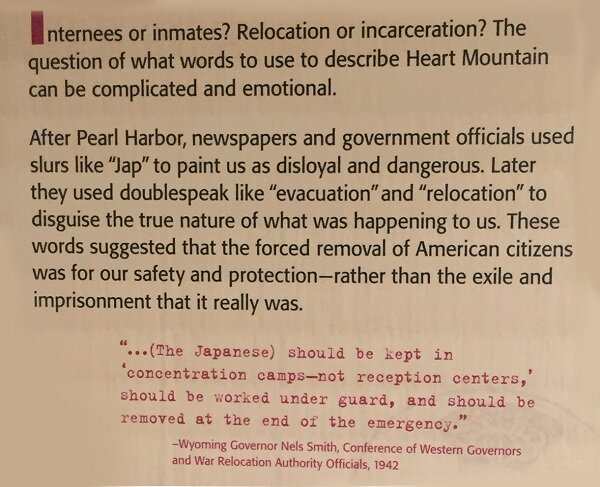 Additional information:
Additional information: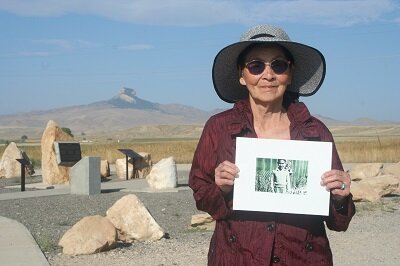 By Will KakuThe Heart Mountain
By Will KakuThe Heart Mountain 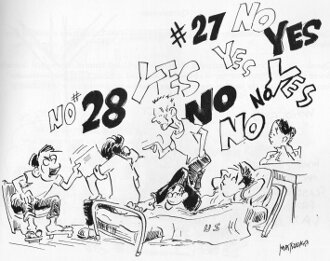 Despite that significance in my family’s history, I could never find the time to make the journey to the
Despite that significance in my family’s history, I could never find the time to make the journey to the 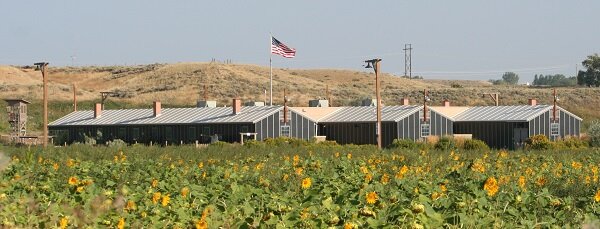 The Heart Mountain Interpretative Center opened in 2011, just a year after we completed the major renovation of JAMsj. Because I assisted in providing content for the JAMsj camp exhibit, I was fully aware of space, cost, and vision constraints that had to be considered in exhibit design. I was keenly interested in how the
The Heart Mountain Interpretative Center opened in 2011, just a year after we completed the major renovation of JAMsj. Because I assisted in providing content for the JAMsj camp exhibit, I was fully aware of space, cost, and vision constraints that had to be considered in exhibit design. I was keenly interested in how the  One major aspect of the HWMF presentation, the first-person narrative, is extremely effective in bringing out an emotional connection to an infamous event in our nation’s history from over 75 years ago. After a short museum overview, my mom and I were encouraged to view the short film, All We Could Carry, by Oscar-winning filmmaker, Steven Okazaki. All We Could Carry powerfully captures the devastating impact of incarceration at Heart Mountain through the voices of former inmates.
One major aspect of the HWMF presentation, the first-person narrative, is extremely effective in bringing out an emotional connection to an infamous event in our nation’s history from over 75 years ago. After a short museum overview, my mom and I were encouraged to view the short film, All We Could Carry, by Oscar-winning filmmaker, Steven Okazaki. All We Could Carry powerfully captures the devastating impact of incarceration at Heart Mountain through the voices of former inmates.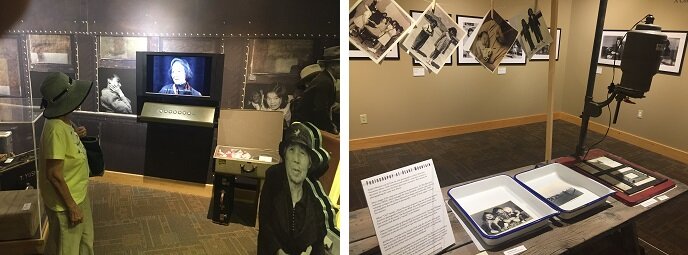
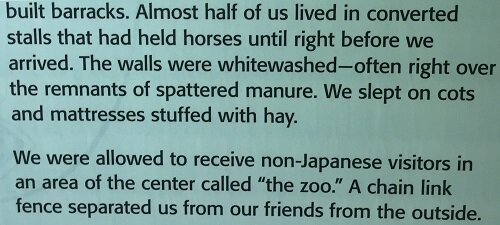 Several kiosks in the museum also incorporate moving first-person accounts. Exhibit placards continuously reinforce the first-person point of view by utilizing the inclusive pronoun "we". We felt that we were also making our own journey through the great civil liberties and human rights tragedy from WW II.
Several kiosks in the museum also incorporate moving first-person accounts. Exhibit placards continuously reinforce the first-person point of view by utilizing the inclusive pronoun "we". We felt that we were also making our own journey through the great civil liberties and human rights tragedy from WW II.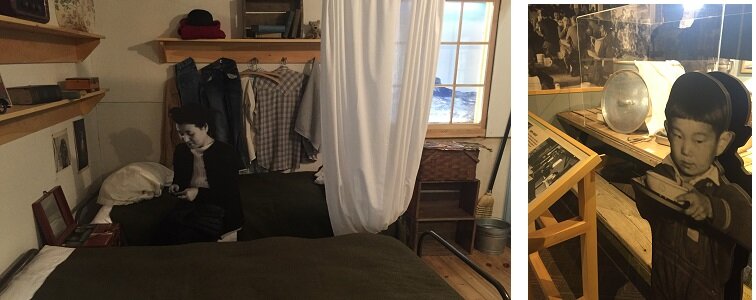 The 11,000 square feet of space also enables exhibit images and artifacts to extend out into the floor space, providing a fully immersive experience to the visitor.
The 11,000 square feet of space also enables exhibit images and artifacts to extend out into the floor space, providing a fully immersive experience to the visitor.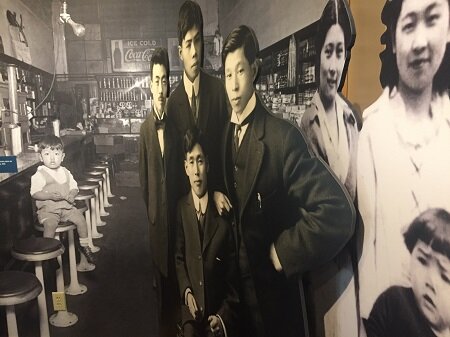 Every square foot of the museum is used to transport you back into the diverse and complex Japanese American incarceration experience. Even the reflective restroom toilet stalls convey the feeling of embarrassment and the loss of privacy that many former inmates experienced in the camps.
Every square foot of the museum is used to transport you back into the diverse and complex Japanese American incarceration experience. Even the reflective restroom toilet stalls convey the feeling of embarrassment and the loss of privacy that many former inmates experienced in the camps.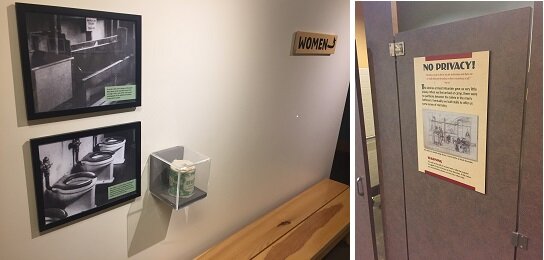 Importantly, the museum exhibits challenge visitors with questions that are pertinent to our lives and political discourse today. One display asks us about what we think about the 14th Amendment and birthright citizenship. Another asks us if there are any circumstances under which the curtailment of civil liberties by the government is justified.
Importantly, the museum exhibits challenge visitors with questions that are pertinent to our lives and political discourse today. One display asks us about what we think about the 14th Amendment and birthright citizenship. Another asks us if there are any circumstances under which the curtailment of civil liberties by the government is justified.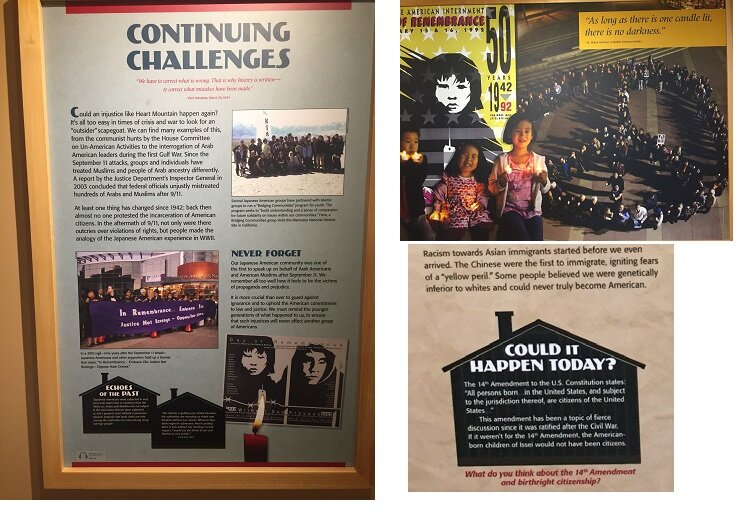 It took us a long time to explore the many museum displays and my mother became tired. We came back the next morning and wandered around the self-guided walking tour next to the museum. We saw the locations of the Heart Mountain hospital where my father worked for a short time, the school that he attended, and the train station where my father boarded a train that transferred him to the Tule Lake camp. We walked solemnly during that quiet, cool morning and we reflected on his life.
It took us a long time to explore the many museum displays and my mother became tired. We came back the next morning and wandered around the self-guided walking tour next to the museum. We saw the locations of the Heart Mountain hospital where my father worked for a short time, the school that he attended, and the train station where my father boarded a train that transferred him to the Tule Lake camp. We walked solemnly during that quiet, cool morning and we reflected on his life.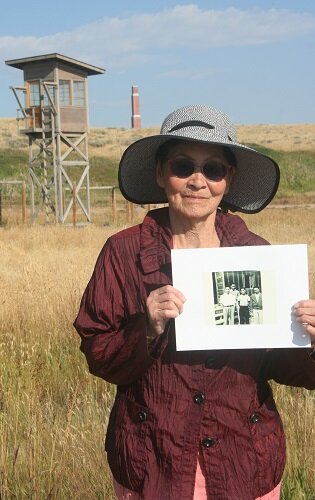
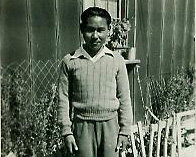
 --------------------------------------------------------------------------------------------------------------------------------------Related articles by Will Kaku:
--------------------------------------------------------------------------------------------------------------------------------------Related articles by Will Kaku: